Make the Law of Cause and Effect Work for You
How can you make the Law of Cause and Effect work for you? Do you wonder about the coincidences that happen in life? In your worldview, do you believe everything is connected and that actions create ripples? Can you envision a cosmic plan unfolding in life? Then you may understand that there is a larger story to our existence. When you view things this way, you can appreciate the intricate tapestry of life, and you can harness the law of cause and effect to work for you.
“When we do align with it, we thrive. And when we do not, we suffer. This is not “punishment.” It is merely the Law of Cause and Effect. With each thought we think, we either align with universal love or we disconnect ourselves from it. Whichever is our choice determines whether we then feel connected to, or disconnected, from our own true Selves.” – Marianne Williamson
merely the Law of Cause and Effect. With each thought we think, we either align with universal love or we disconnect ourselves from it. Whichever is our choice determines whether we then feel connected to, or disconnected, from our own true Selves.” – Marianne Williamson
This is part seven of a twelve-part series about ancient mystical teachings called the Universal Laws or Hermetic Principles. The focus of this article is twofold; The Law of Cause and Effect (also called the Law of Karma) and creating art exploring this principle.
Many believe that by harnessing the Universal Principles, you can achieve inner peace, a deeper connection to the universe, and a greater understanding of yourself.
In my Soul Artist Experience series of classes, we explore the Universal Laws among many other topics. Using our art journals to examine each principle illustrates our insights.
Soul Artists have rich material for inspiration as they learn the Law of Cause and Effect and create art journal pages about this law.
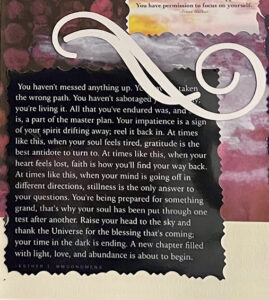 For example, artistically conveying that every effect noticed in the physical world has a specific cause, which originated in the inner or mental world. Other art approaches may be creating pages communicating concepts such as witnessing choices, being fully conscious in the present moment, and listening for inner guidance. Showing how meditation can mediate the impact of karma is another approach; as well as conveying the concept of reaping what you sow.
For example, artistically conveying that every effect noticed in the physical world has a specific cause, which originated in the inner or mental world. Other art approaches may be creating pages communicating concepts such as witnessing choices, being fully conscious in the present moment, and listening for inner guidance. Showing how meditation can mediate the impact of karma is another approach; as well as conveying the concept of reaping what you sow.
As I began to learn more about the ancient wisdom traditions, I had a lot of questions about karma. In fact, this is a topic I continue to study. I will share in this article what I am learning.
“The universal law of karma is that of action and reaction, cause and effect, sowing and reaping. In the course of natural righteousness, man, by his thoughts and actions, becomes the arbiter of his destiny.” – Paramahansa Yogananda
This law is often referred to as the law of karma. In Sanskrit, karma is the concept of “action” or “deed.” There is a continuity between all events precedent, consequent, and subsequent. A relationship exists between what has gone before and what follows.
events precedent, consequent, and subsequent. A relationship exists between what has gone before and what follows.
You get back what you send out. The choices or decisions you make will set in motion a chain of reactions and give you back a result corresponding to whatever that decision triggered.
The law of cause and effect tells us that “every cause has its effect; every effect has its cause.”
The New Testament expresses it as, “Whatsoever a man soweth, that shall he also reap.”
My husband, Rich engages often in random kindnesses that he jokingly refers to as ‘good karma’; like picking up after other people’s dogs as we go on our daily walk. He says; ‘see, Bella, this is good karma. We’re intentionally leaving things better than we found them.’
However, most spiritual teachers say karma is neither good nor bad; it is neutral. A complete understanding of karma presupposes a belief in reincarnation.
 Some teachers describe karma as “cosmic debt.” It has also been described as a lack of balanced experiences.
Some teachers describe karma as “cosmic debt.” It has also been described as a lack of balanced experiences.
Books such as Your Soul’s Plan reference karma, describing, for instance, a life where you are now a caregiver for a person with a physical disability. Maybe in a prior life, you had a physical disability, and the person you care for was caring for you. Or if you abandoned someone in a prior lifetime, then you restore balance by experiencing abandonment.
So, along this line of thinking, karma is not necessarily balanced by “doing good” for someone else.
Karma is more about the insights and lessons from your experiences that you obtain along the way.
I’ve heard some spiritual teachers say we can get addicted to trying to focus on good karma.
Some teachers also distinguish between balancing and burning or releasing karma. Karma is balanced when the soul has experienced the full perspective of an issue—all sides. Karma is released or “burned” when the underlying causes of the original imbalance are resolved.
Because this thinking goes—until you heal the issues that are underlying the karma, you can create new karma even after the original karma was balanced.
Karma means action or the energy created from an action. Energy is neither good nor bad—so karma is also neutral.
Maharishi Mahesh Yogi said, “Everything is set, but everything can be changed.” I interpret this as a reminder that we always have a choice and free will to respond to any situation with conscious intention.
In further research I learned that there are three types of karma:
Prarabda Karma is responsible for the present.
We are processing parabda karma during this lifetime. Teachers explain that the things done in the past make you what you are today. This type of karma can only be exhausted by being experienced.
Sanjita Karma is additional karma we are storing to be dealt with at some later time.
This accumulation of karma from past lifetimes is comprised of former deeds and actions that have been taken, but this karma is not actively being processed through current experience.
The new karma we are creating every moment is called Agami Karma.
Agami karma is the action that we create and the choices we make right now, as we live this present lifetime.“As you think so shall you be” –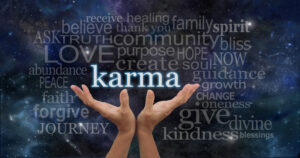 our choices and actions of the present moment will become our karma in the future.
our choices and actions of the present moment will become our karma in the future.
Vedanta teaches that between human incarnations, the soul rests in the astral plane. When the soul is ready to reincarnate and work through some of its karma, many teachers explain that certain ‘contracts ‘ are agreed upon. For example, two souls agree to be your parents. As the incarnation begins at birth, the contract is activated.
The seeds of karma exist and must be released, but through our choices, we can minimize its effects in our lives.
Some spiritual teachers believe that we plan our lives. It follows that situations in life and people we meet are a result of our karma. We have, on a cosmic level, ‘asked for’ situations to enable us to release that karma.
I have come to believe that when we struggle against the life situations we encounter, we are making a choice. Through that choice, we are failing to balance or release karma.
 In considering karmic balance, my mind often goes to forgiveness, acceptance, surrender, gratitude, and grace.
In considering karmic balance, my mind often goes to forgiveness, acceptance, surrender, gratitude, and grace.
If everything is planned for a potential release of the karma we asked to experience, shouldn’t we be grateful for everything in our lives?
We can create karma with every action, word, and thought in our lives. By living more consciously, we can minimize new karma which will have to be released at some later date.
Some spiritual teachers say that meditation is the single most powerful tool we have when addressing karma.
I actually had an opportunity to ask Dr. Deepak Chopra about this in person. My question was, “I once read that when a person meditates, they burn karma; do you believe this is true?” and he said “Definitely,” and he talked about ourselves after what he referred to as ‘conditioning.’ He said; “when we are born, we are like a fresh snowy white cloth. Then conditioning happens from our parents, bosses, and all of our life experiences, and thus, our cloth becomes dingy and dirty. Every time we meditate, it is like dipping the cloth in a stream of clear water. Each time, some of that conditioning washes away, and the cloth becomes cleaner every time you dip it in the stream.”
As I became certified as a meditation coach, I learned even more from one of my beloved teachers, Roger Gabriel.
He explained; “Through meditation, our consciousness expands, helping us to reduce the impact of contracted karma. The practice also gives us the awareness to avoid creating new karma and dissolve stored karma.
Karma is locked away in our memories and desires, both of which are in the mind.
The karma being processed during this incarnation is in the conscious mind, while the remaining, stored karma is lying dormant in what we refer to as the unconscious mind.
Meditation takes us beyond the mind to the realm of infinite possibilities. We transcend thought memories and desires.
The journey back and forth from local to nonlocal in meditation “washes” the karma on all levels.
This is exciting news for those of us on a spiritual path.
We all have the potential for greater enlightenment in this lifetime.
The contracted karma can be released during our life in a couple of ways. First, by making conscious choices, we can avoid adding new karma. And secondly, through the process of meditation, we can transcend any karma left.
To harness the power of the law of cause and effect, be aware of how your actions and decisions impact not only you but everyone around you. Focus on making conscious choices that harm no one, benefit the greater good, and the highest and best outcome.
If you want to learn more about the Universal Laws or would like to explore making art as a spiritual practice, we would love to include you in our Tribe of Soul Artists. Learn more.
Thank you for reading this post. Feel free to share it.
Gratitude and thanks to the Soul Artists who have shared their work for this post;
Kathy Kellum, Teresa Henke, and Cheryl Thompson.
Find out more about my journey through my book on Amazon: Vision Quest; A Journey to Happiness by Jane Ramsey.
View my YouTube video about freeing your inner artist.
Watch my YouTube video explaining the courses I teach.
See my YouTube video about the Law of Karma.
To learn more about Chakras read the Blog below:
Understanding Chakras
Practice gentle chakra tuning
Interested in the Universal Laws? The Blogs for each of the 12 Laws are found below:
1. Divine Oneness

Jane Ramsey
2. Vibration
3. Correspondence
4. Attraction
5. Inspired Action
6. Perpetual Transmutation of Energy
7. Cause and Effect
8. Compensation
9. Relativity
10. Polarity
11. Rhythm
12. Gender

Jane Ramsey is an Executive Contributor for Brainz Magazine
Find out more about Jane Ramsey


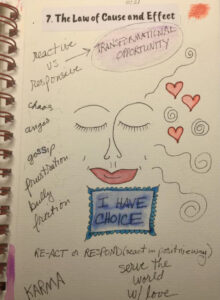 Some teachers describe karma as “cosmic debt.” It has also been described as a lack of balanced experiences.
Some teachers describe karma as “cosmic debt.” It has also been described as a lack of balanced experiences.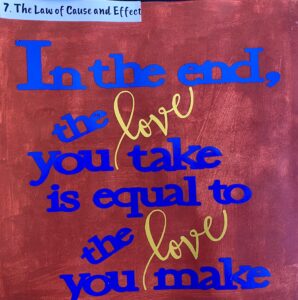
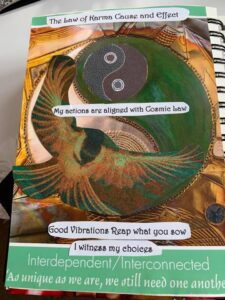 In considering karmic balance, my mind often goes to forgiveness, acceptance, surrender, gratitude, and grace.
In considering karmic balance, my mind often goes to forgiveness, acceptance, surrender, gratitude, and grace.



